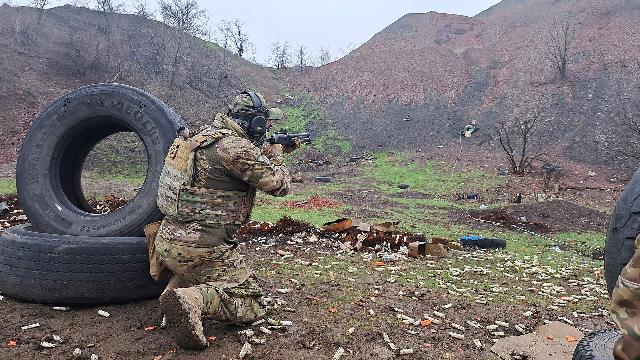The best athletes are involved in the training of military personnel
As kamikaze drones with fiber-optic cable control spread, smoothbore rifles became the main means of protection for soldiers. But they have never been in service, so there is no practice of using them. Therefore, civilian shooters and athletes with extensive experience in working with smoothbore rifles and bench shooting come to the rescue. Izvestia correspondents took part in anti-UAV courses with 12-gauge rifles held in the 87th Regiment of the 51st Donetsk Army, and learned from personal experience how fighters master this type of weapon.
How are the rifle shooting trainings going?
In the army today, you can find an exceptional variety of models of rifles — from double-barreled shotguns of the 60s to semi-automatic carbines "Saiga" and "Boar" based on Kalashnikov automation. They are needed at all levels and in all branches of the armed forces, so they come fresh from factories, from police confiscation, and even from volunteers. Often, military personnel from vacations bring their own copies of hunting weapons. Therefore, there is the same variety of models on the table in front of the trainees. Some decide to master those that are already in the unit, others choose the most common model, officers try to master the maximum of those presented in order to train the personnel later.
Classes begin with firing at a ground target. Movies and computer games have formed the stereotype that it's easy to shoot a shotgun — the inaccuracy of the shot is compensated by the scattering of the shot over a large area. This is both true and not true. The first shot is relatively easy to make, but the problem is recoil.

Photo: IZVESTIA/Dmitry Astrakhan
Image source: iz.ru
The 12-gauge hits the shoulder much harder than the Kalashnikov assault rifle, which is familiar to most of the audience. The weapon throws up unusually, and repeated shots go much worse. The vast majority spend much more time trying to return the gun to the target than they expected. The shoulder starts to hurt quickly, more than when shooting rifles, and bulletproof vests do not allow you to comfortably put the butt.
Anna Taranosova, the Russian champion in practical shooting, helps fighters quickly master the weapons tab and stance, which should be noticeably tougher than when working with machine guns. One of the fighters is noticeably deflected back when fired from the Saiga, the barrel is visible, and Anna once again explains how to bend her legs and tilt her body forward, but an officer who had completed this lesson a little earlier intervenes with a quick "military-style" explanation.
"It's like you're going to fight someone!" Lean forward, get ready! — my grandfather from the 87th regiment helps. He specializes in teaching medicine, was a militia member in the DPR, then an instructor in the PMCs, then he joined the Armed Forces of the Russian Federation, so he has extensive combat experience.
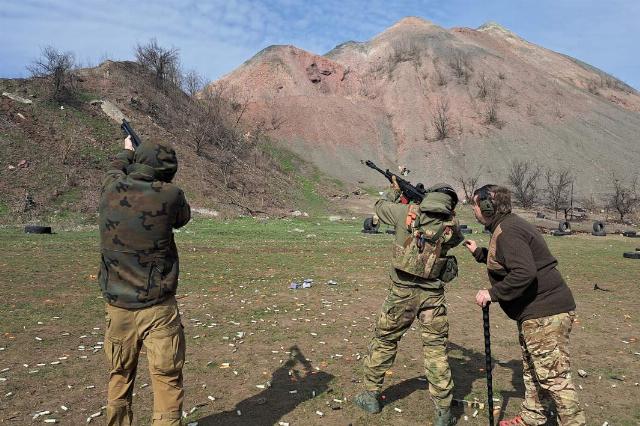
Photo: IZVESTIA/Dmitry Astrakhan
Image Source: iz.ru
The grandfather stands in front of the trainee and pretends to be ready for sparring, encouraging the fighter to imagine that he needs to fight. Together with another soldier, he, without wasting time on unnecessary conversations, puts the legs and the body of the shooter in the necessary position.
— It's right that athletes teach the military. They didn't come into shooting just like that, bang — and you can do anything! No, they gradually gained experience, they were also taught. And they themselves, based on their experience, teach how to invest properly, how to stand up properly and aim at a moving target," the Grandfather explains.
Those who have first become familiar with the gun begin the path between different types of targets. Plates for bench shooting serve as imitation drones. But the launch vehicles are not installed according to sporting standards, but in such a way as to give a target close to combat. The simplest target simulates a drone flying over a position without attacking. At the turn, the fighters are actively shooting in twos and threes, while the rest are loading, opening more and more boxes of cartridges. The goal is not just to aim, but also to take pre—emption, and you need to get used to it, which is again helped by experienced athletes in bench shooting.
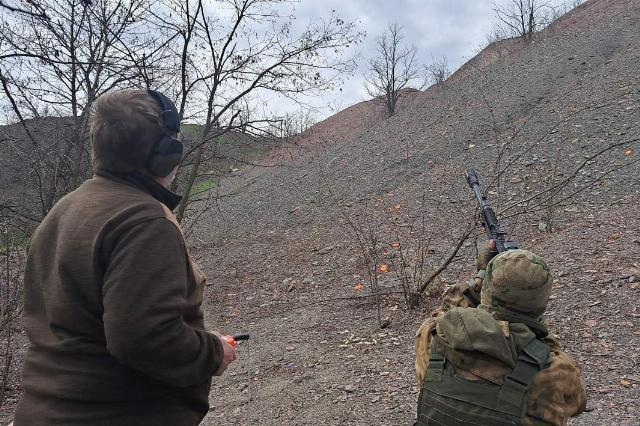
Photo: IZVESTIA/Dmitry Astrakhan
Image source: iz.ru
The next exercise becomes more complicated again: in it, the plate is already moving towards the shooter at low altitude, simulating a kamikaze drone attack. Here, pre-emption is no longer as important as the speed of reaction and aiming.
The third machine launches dishes along the terrain, simulating the appearance of a drone due to the terrain, trees and bushes. This exercise is even closer to combat conditions. Ahead of the "program" of training, many people begin to habitually take cover and try to shoot from the knee. By the way, most people benefit from military experience here: shooting through branches and bushes does not cause problems, many are used to it and know that fire is effective through vegetation. Therefore, it is easier to lead a goal without being distracted by insignificant obstacles.
— This is a very realistic training. The fighters understand the mechanics of how to fire. The whole story is perfectly transferred to the fighting. As a rule, the most common feedback from those who have completed the training is that excitement has appeared. The fighters say that now it's not drones that hunt them, but they hunt drones," says Anna Taranosova. She emphasizes that instructor athletes do not teach military personnel combat tactics, but introduce them to previously unknown types of weapons and shooting techniques.
How long does shooting training take?
The first day of training is coming to an end, when even the most avid shooters can hardly raise their weapons. But even so, knowing about the danger of drones firsthand, they shoot until the cartridges allocated for the day of classes run out. Athletes explain that during the day of express training, the military shoot several times more than civilian shooters during full-fledged training.
Approaching the target once again, the author, raising the gun, realized that his hands were no longer holding the weapon on the aiming line, and there was still the second day of classes ahead. Anna explains that with the possibility of long–term training, you can give a good level to shooters with 1.5-2 thousand rounds in 10-12 days. The audience has two or three days, and everyone is trying to make the most of it.
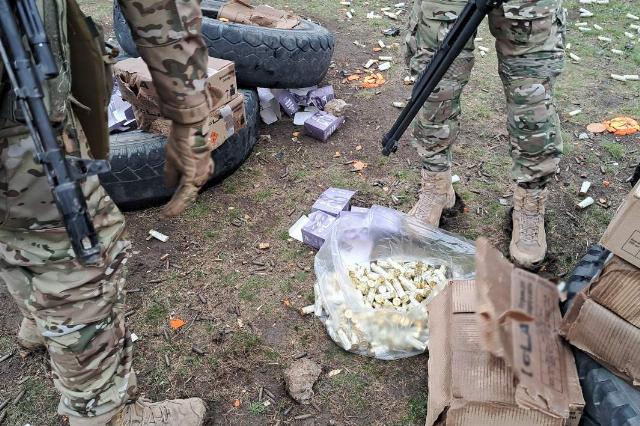
Photo: IZVESTIA/Dmitry Astrakhan
Image source: iz.ru
On the second day, all three dish launch machines are already working at the same milestone and the tasks are becoming more complicated. One by one and in groups, the fighters practice their actions during group raids by kamikaze drones from different directions. Firing from behind shelters and moving between them is added. And at the end of the training, the most interesting task is as close to combat conditions as possible: at the beginning of the exercise, the fighter works on a target from a machine gun, changes weapons at the command "air" and tries to hit a real FPV drone with a rifle. The first person to hit the real target will receive a small prize from the organizers. At the end of the day, the dish launch machines are removed from the terricons and prepared for shipment to new units and places of study.
One of the organizers of the training, Sergei Lynya Parshikov, a militia veteran and volunteer, says that while working on anti—aircraft machine—gun systems based on pickups to combat aircraft-type UAVs, he witnessed how, jumping off a car, an anti-aircraft gunner defended himself from a kamikaze raid by shooting down an FPV drone with a rifle. It became clear that it was necessary to train people and conduct field sessions.
— The 87th Regiment is a reinforcement unit, and the fight against drones is very important to it. We have brought here more than 10 thousand cartridges, plates and professional equipment. The most important thing is that instructors from St. Petersburg, Tomsk, and Moscow have arrived. Everyone quit their jobs and helped the boys. They are really satisfied and happy, the regiment has worked for three days on training," Sergei Parshikov sums up his work in Donetsk.
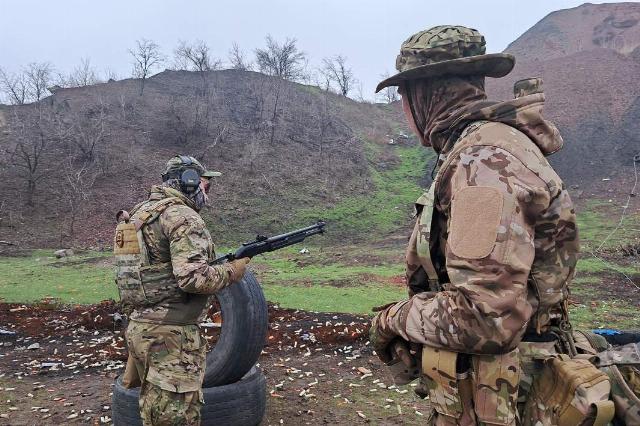
Photo: IZVESTIA/Dmitry Astrakhan
Image source: iz.ru
This is already the 11th course, and at the moment they are becoming regular in all areas of the front.
Dmitry Astrakhan
